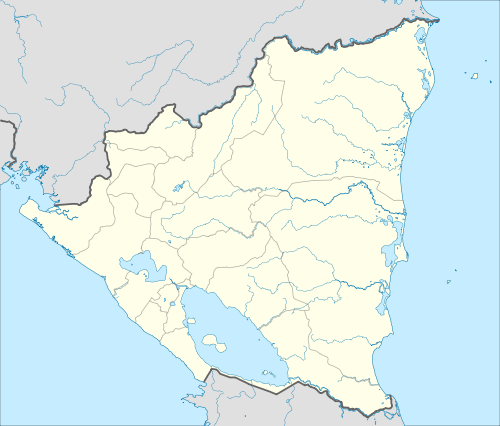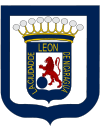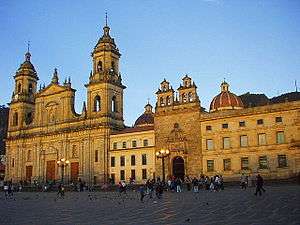León, Nicaragua
| León | |||
|---|---|---|---|
| Municipality | |||
| Santiago de los Caballeros de León | |||
|
Catedral de la Ascunción de María (Mary's Assumption Cathedral) | |||
| |||
 León Location in Nicaragua | |||
| Coordinates: 12°26′0″N 86°53′12″W / 12.43333°N 86.88667°WCoordinates: 12°26′0″N 86°53′12″W / 12.43333°N 86.88667°W | |||
| Country | Nicaragua | ||
| Department | León Department | ||
| Area | |||
| • Municipality | 591.07 km2 (228.21 sq mi) | ||
| Elevation | 86 m (282 ft) | ||
| Population (2012) | |||
| • Municipality | 210,615 | ||
| • Urban | 201,100 (2nd Nicaragua) | ||
| • Metro | 389,600 | ||
| Time zone | Central (CST) (UTC-6) | ||
León (Spanish pronunciation: [leˈon]) is the second largest city in Nicaragua, after Managua. It was founded by the Spanish as Santiago de los Caballeros de León and rivals Granada, Nicaragua, in the number of historic Spanish colonial churches, secular buildings, and private residences. As of 2012, the city had an estimated population of 201,100.[1] which increases sharply during university season with many students coming from other regions of Nicaragua. It is the capital and largest city of León Department.
León is located along the Río Chiquito, some 90 kilometres (56 miles) northwest of Managua, and some 18 km (11 miles) east of the Pacific Ocean coast. León has long been the political and intellectual center of the nation and its National Autonomous University of Nicaragua (UNAN) was founded in 1813, making it the second oldest university in Central America. León is also an important industrial, agricultural, and commercial center for Nicaragua, exporting sugar cane, cattle, peanut, plantain, and sorghum. The city has been home to many of Nicaragua's most noteworthy poets including Rubén Darío, Alfonso Cortés and Salomón de la Selva.
History
The first city named León in Nicaragua was founded in 1524 by Francisco Hernández de Córdoba about 30 kilometres (20 mi) east of the present site. The city was abandoned in 1610 after a series of earthquakes. The ruins of the city are known as "León Viejo" and were excavated in 1960. In the year 2000, León Viejo was declared a UNESCO World Heritage Site.
León had been the capital of Nicaragua since colonial times, so naturally when Nicaragua withdrew from the United Provinces of Central America in 1839, León became the capital of the new nation. For some years the capital shifted back and forth between León and Granada, Nicaragua, with Liberal regimes preferring León and Conservative ones Granada, until as a compromise Managua was agreed upon to be the permanent capital in 1858.
In 1950 the city of León had a population of 31,000 people. Nicaraguan President and dictator Anastasio Somoza García was shot and mortally wounded in León on September 21, 1956.
Heritage
León is rich in both monuments and historical places. Some architectural monuments include:
- Cathedral Basilica of the Assumption of León, typical colonial baroque building built between 1747 and 1814. Because of its solid, anti-seismic construction its walls have endured earthquakes, volcanic eruptions of Cerro Negro volcano, and bombings during civil wars. Several cannons were placed on the roof both during the siege of the city by conservative forces in 1824 and during the Revolution of 1979 against dictator Anastasio Somoza Debayle.
- The Assumption is the largest cathedral in Central America while it has been the first episcopal seat of Nicaragua since 1531, making it one of the oldest dioceses in the Americas. In the cathedral's crypts are buried several illustrious figures such as poet and diplomat Rubén Darío, at the foot of the statue of St. Paul. Darío is the leading figure of the Modernism Poetic Movement of the late 1800s to early 1900s and was declared the Prince of Spanish Letters by literary figures of the Spanish speaking world. Other illustrious figures buried at Leon's cathedral are poets Salomón de la Selva and Alfonso Cortés, father of independence Miguel Larreynaga, classical composer and musician José de la Cruz Mena, and several bishops.
- There are a number of tunnels that connect the Cathedral with other temples that were used as hideouts or escape routes during terrorist attacks by British, Dutch, and French pirates. However, the tunnels are not accessible to the public for some have been converted to the sewer system service. In the early 20th century the first bishop of León and last in Nicaragua, Archbishop Simeón Pereira y Castellón (the same who presided over the funeral of Darío on February 13, 1916) commissioned Granadan sculptor Jorge Navas Cordonero to make a statue of the Virgin Mary to crown the top the façade, and two pairs of Atlanteans to support the beams that connect the central gable to the flanking bell towers. Navas also sculpted the statues of the Twelve Apostles inside, along with the columns of the central nave, and the lion at the tomb of Dario, which resembles the Lion of Lucerne, Switzerland. Navas also created several moldings in the interior walls and built the Tabernacle Chapel.
- Church of Subtiava was considered the main temple after the cathedral. Its construction began in 1698, during magistrate Diego Rodríguez Menéndez administration and was completed August 24, 1710. In 1844, during the war with El Salvador, the tower dome was destroyed but it was re-built in the early 20th century.
- Church of San Francisco is part of the convent of San Francisco, one of the oldest in Nicaragua, founded in 1639 by Friar Pedro de Zúñiga. In the interior remain two good examples of plateresque altars. However, its main attraction is the outstanding courtyard. Built in pure, Leonese colonial style, this is a grassy expanse with an ashlar fountain at the center from which four radiating walkways, flanked by manicured lemon trees, lead to the surrounding porticoes where some of the columns are covered in red bougainvilleas. Towards the south, a line of Royal palms shade the roof and complete the peaceful ensemble.
- Church of la Recolección, construction began on December 5, 1786, by Bishop Juan Félix de Villegas thanks to contributions made by parishioners. Its outstanding Mexican baroque façade is considered one of the most important in the city. The interior also contains one of the best baroque altarpieces in the city highlighted with paintings and silver engravings.
- Church of la Merced, in 1762 the Mercedarian fathers built the first convent and church but these were demolished later. In the 18th century the present Church of la Merced was erected with drawings attributed to Mercedario Friar Pedro de Ávila and conducted by master builder Pascual Somarriba. Adjacent to the north side of la Merced is the Paraninfo (former Mercedarion convent) built in beautifully delicate Baroque style which is now UNAN's main administrative building.
- Church of el Calvario, a fantasy of textures and colors of pure Leonese baroque. The façade consists of a central body, painted off-yellow with white trimming supported by white, half columns. The gable contains high reliefs of the passion of Christ. The two flanking bell towers painted Burgundy red and highlighted with white grooving, are made up of righ reliefs representing bricks. The central body contains a central Roman arch door flanked by two smaller, flat ones. They are all separated by columns, topped by a frieze covered in white garlands. The interiors are a pleasant soft white to keep them cool during the long, hot, and dry Leonese summers. The ceiling, also white, is highlighted by red and yellow outlining in the shape of crosses, leaves, and flowers. Built by the illustrious Mayorga family, el Calvario dates from the first half of the 18th century and it is one of Leon's architectural jewels at the east end of calle Real or "Main Street".
- Ruins of the Church of San Sebastián, built in the late 17th century as a chapel of the Cathedral, San Sebastián's was one of the first religious buildings in the city. Re-built in the late 18th century by Colonel Joaquín Arrechavala, it was bombed during the siege of León by airplanes of the regime's Nicaraguan Air Force (FAN) in 1979. Since it was built with adobe bricks San Sebastián's was easily destroyed, unlike other churches built in brick or stone which endured shootings and bombings.
- Church of Guadalupe, built in the late 19th century under the auspices of father Villamil replacing an 18th-century hermitage, it is of simple construction, in keeping with the sobriety of the Franciscans.
- Church of Zaragoza, with an atrium and lateral corridor, its construction began in the late 19th century and ended in the mid-20th century by Bishop Salmerón, the façade was designed by Dr. Francisco Mateo.
- Church of San Felipe, a large building that occupies an entire block, it was built in 1685 for blacks and mulattoes worshipers. In 1859 it underwent an extensive expansion that gave it its present form, whereas the tower was restored in 1983.
- Church Hermitage of San Pedro, a small building with typical late, colonial architecture of the 18th century. It was built between 1706 and 1718 by mayor Bartolomé González Fitoria, replacing the original church of San Pedro that was part of a set of four primitive hermitages in Subtiava.
- Church of San Nicolás Tolentino del Laborío, Philip III of Spain ordered its construction in 1618. It was built in very light, Colonial baroque style.
- Chapel of la Asunción, part of the school of the same name it was built in 1679 by Bishop Andrés de las Navas y Quevedo, and used as an episcopal palace. Later it was occupied by the Mothers of the Assumption. In 1935 it underwent deep alterations that led to the its current appearance: a mix of early colonial baroque for the side wings, and neo-Gothic for the central chapel.
- Hotel Esfinge building designed by Nicaraguan architect José María Ibarra as an upscale hotel.
- Esquivel House. Built in the 19th century it belonged to Father Mariano Dubón. Architectural details and decorations around the house makes it a unique structure in the city. It now belongs to the Esquivel Family and it is categorized as high-class residence.
- Colegio de San Ramón, of symmetrical façade and Renaissance influences it has been rebuilt several times after being damaged by earthquakes. Although historically a seminary college since the 1600s, it has now been incorporated to UNAN.
- City Hall, built in 1935, it was damaged by Somoza's National Guard during the Revolution of 1979 led by the FSLN. The building was designed in Art Deco style by architect Marcelo Targa, precursor of neoclassical architecture in Leon, and built during the administration of then president Juan Bautista Sacasa. It is a building of important architectural value.
Other remarkable buildings and places include the walls of Guadalupe Cemetery, Guadalupe Bridge, the Debayle Museum, the Diocesan Archives, the Mena Theater, the Posada Colonial (a baroque jewel in business since 1823), the old Train Station, San Vicente Hospital, and the Subtiava Rural House.
- León Viejo, the ruins of the ancient city of León which was buried by eruptions of the Momotombo volcano, most of them in 1610. Was founded in 1524 by Francisco Hernández de Córdoba, it is situated 30 kilometres (19 miles) from the modern city, is a World Heritage Site and in this is buried its founder, in a crypt, beneath his statue along with other figures including Pedrarias Dávila his murderer.
- Sesteo Restaurant near Cathedral and Main Square.
- Church El Calvario.
- Spanish colonial home.
- Spanish colonial home.
- Couple at Poneloya Beach, just outside León.
- Poneloya Beach, just outside Leon at sunset.
 Church of La Recolección
Church of La Recolección
Geological features around Leon include:
- Poneloya beach, a major tourist destination on the Pacific Ocean.
- San Jacinto Swarms, geothermal place at the base of Santa Clara volcano which form part of its vents. This phenomenon is known as Thermal sharpen to simmer.
- Momotombo volcano, with its 1,300 m (4,270 ft) summit, it is a visual reference in the Leonese landscape. At its feet lies León Viejo. Momotombo name is a Native American word for Great Summit Burning. There is a geothermal power plant on the foothills.
- Cerro Negro volcano, one of the youngest in the world (1850), Cerro Negro has wrought havoc several times to the city of Leon and its surrounding area since it was born with long, sky-clogging, and destructive ashfalls, the most recent in 1995.
Notable people
- José de la Cruz Mena, classical composer (1874–1907).
- Azarías Pallais, poet and literary figure (1884–1954).
- Alfonso Cortés, poet (1893–1969).
- Salomón de la Selva, poet, writer, diplomat, translated W Whitman to Spanish (1893–1959).
- Antenor Sandino, metaphysical poet (1899–1969).
- Anastasio Somoza Debayle, Nicaraguan president (1st term: 1967–1972, 2nd term: 1974–1979); overthrown by the Sandinistas.
- Enrique Bermúdez, Contra leader (1932–1991).
International relations
Twin towns and Sister cities
León is twinned with:
|
|
See also
References
- ↑ http://www.inide.gob.ni/estadisticas/Cifras%20municipales%20a%C3%B1o%202012%20INIDE.pdf
- ↑ "Oxford's International Twin Towns". Oxford City Council. Archived from the original on 2013-08-17. Retrieved 2013-09-03.
External links
![]() Media related to León, Nicaragua at Wikimedia Commons
Media related to León, Nicaragua at Wikimedia Commons
| Wikivoyage has a travel guide for León (Nicaragua). |



